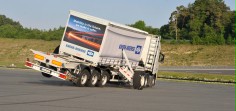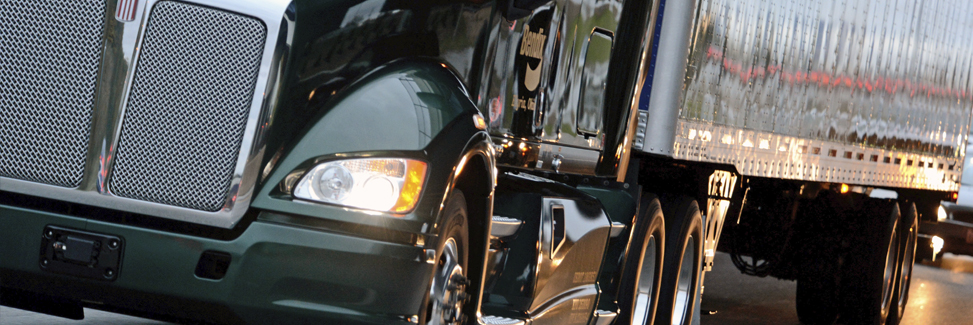Vehicle testing in Boxberg

Greater safety through ESP for road trains
The EU has announced its intention to halve the number of road deaths in Europe by the year 2010, and is aiming to introduce stricter regulations not just for passenger cars but also for commercial vehicle manufacturers. By 2011 at the latest, ECE Regulation 13 will require the ESP electronic stability program to be installed as standard in certain categories of commercial vehicle (semitrailers and coaches). It will subsequently be phased in for other categories as well.
The basic function of ESP is to automatically stabilize a vehicle in critical driving situations. The system monitors current vehicle status and the driver’s operation of the steering wheel and pedals several hundred times a second. If there is any divergence between the driver’s intentions and the reality of the situation, or if the lateral acceleration of the vehicle increases too rapidly, then these are the first signs that he may be losing control of his vehicle. If, for example, there is a sudden drop in the friction coefficient of the tires as the vehicle negotiates a left-hand bend, then there is a danger of understeer and the vehicle skidding off the road to the right. At this point ESP intervenes by applying the brakes on individual wheels – in this case mainly those on the left-hand side – until the vehicle returns to its proper course. If necessary the engine power is also reduced. During the process, ESP also monitors the effects of its intervention about a hundred times a second until the readings return to an acceptable range and the vehicle is under control once again. Usually this automatic application of the brakes takes place before the driver has even become aware of the danger. The main challenge to the designers of the system was to ensure that it effectively covers all driving situations but that ESP only intervenes when the situation really has become dangerous.
Knorr-Bremse has now gone further than this: Since the end of 2008 it has been installing ESP in road trains as well. This means that for the first time ever, ESP is available for the full range of commercial vehicles. Developing the system for road trains was a much greater challenge. Unlike semitrailers, a road train has two pivot points – the trailer coupling and the turntable hitch – which means that a wide range of different forces affecting the vehicle had to be taken into account. But the development engineers were successful: The new ESP system actively intervenes to stabilize road trains in emergencies – and can also be easily installed in so-called “EuroCombi” multi-unit vehicles.
For active driver assistance systems to function properly in emergencies a specially-configured, sophisticated braking system is essential. ESP can only prevent accidents if the driver assistance and braking systems are closely coupled via a special interface. As the basis for all its driver assistance systems Knorr-Bremse uses the EBS electronic braking system, which has been subject to continuous improvement ever since its first introduction in 1996 and has now reached its fifth-generation. By networking the ABS and ASR systems, EBS makes it possible for the brakes on the various wheels in a road train to be flexibly controlled according to the particular situation. It also offers integrated coupling force control, which modifies braking force distribution and harmonizes braking between the towing vehicle and trailer.






